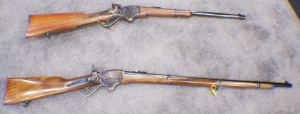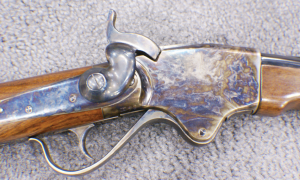by James C. Fulmer NMLRA Past President
This July will be the 150th Anniversary of the Battle of Gettysburg. The battle that took place around this little Pennsylvania town is, in my opinion, the most famous and most studied of all American Civil War battles. As a youngster, I recall making school trips to Gettysburg and remember the pride we Pennsylvanians took in the fact that so many Pennsylvanian soldiers and generals were on the field during the battle. Meade, Reynolds, Hancock, and many others were our heroes.
What happened around Gettysburg, July 1-3, 1863, was an epic struggle between the armies of the North and the South. Gen. Robert E. Lee led the Confederate Army of Northern Virginia and Gen. George G. Meade led the Union Army of the Potomac. Meade was promoted to his command on June 28, 1863—just three days before the first shots were fired at Gettysburg. Maj. Gen. John Reynolds, commander of the Union’s I Corps, was killed July 1, at McPherson’s Woods by a confederate sharpshooter. Maj. Gen.
Winfield Scott Hancock, commander of the II Corps, was temporarily placed in command of Union forces on the field after Reynolds death, until Maj. Gen.
George Meade arrived after midnight and assumed overall command.
Hancock would be remembered on day three of the battle when, during a massive Confederate artillery bombardment of the Union line, he slowly road along the line and gave encouragement to his men. Hancock was wounded and refused to leave the battlefield until after Pickett’s Charge was repulsed. He survived his wounds and died Feb. 9, 1886. He is buried in the Montgomery Cemetery in West Norristown, PA.
Not only the leaders, but many of the units that fought in the forefront during critical phases of the battle were Pennsylvania regiments. They displayed a zeal that only a person defending their hearth and home could display.
Many men from states all over the country fought in the battle 150 years ago—their monuments can all be seen at the National Park. Of the approximately 170,000 officers and men engaged from both sides during the Civil War, more than 50,000 were either killed, captured, wounded, or missing in action.
The Battle of Gettysburg saw many new tactics and firearms coming into their own. The Union’s Brig. Gen. John Buford, in command of the 1st Calvary Division, considered the use of the saber of little practical value. He treated his cavalry as mounted infantry, having his men dismount with every fourth man becoming a horse holder at the rear of the action. On July 1, at the beginning of the action, Buford’s dismounted cavalry was firing various fast loading carbines. They were armed with Sharps, Burnsides, Merrills, Ballards, and Maynards.
One of the more famous repeating rifles at Gettysburg was the Spencer. In February 1863, Gov. Austin Blair of Michigan purchased 680 of these repeating rifles (not carbines) with state funds. These were issued to Col. Russell Alger’s 5th Michigan Cavalry. Alger had 80 of these rifles given to a sister regiment, the 6th Michigan Cavalry.
Both of these units were part of a larger brigade that was assigned to the newly promoted Brig. Gen. George Armstrong Custer. The Michigan Brigade, sometimes called the “Wolverines,” was comprised of the 1st, 5th, 6th and 7th Michigan Cavalry. They would go on to fight in every major engagement from the Battle of Gettysburg in July 1863 to the surrender of Gen. Lee at Appomattox Court House in April 1865.
The men of these regiments made good use of their Spencer rifles. On July 2, after 4 p.m., the Battle of Hunterstown took place northeast of Gettysburg. It was there where Custer would make a name for himself as a gutsy cavalry commander and helped relieve the pressure on Culp’s Hill and Cemetery Hill at Gettysburg. The next day, July 3, the cavalry battle east of Gettysburg stopped the Confederate cavalry in their tracks. The Michigan Cavalry and their Spencer rifles made a name for themselves that would follow them throughout the war.
The Spencer rifle was the unique invention of Christopher Minor Spencer.
While working for the Colt Manufacturing Company in Hartford, CT, Spencer became interested in gun manufacturing.
In 1860, he applied for and received a US patent for his repeating rifle. It was a single-shot, magazine feed, which used a large metallic cartridge—a 56/50 Spencer rimfire. In 1860, Spencer priced his rifle at $45 in comparison to an 1861 Springfield muzzleloader costing $14.
Needless to say, the army passed over the Spencer for the cheaper and timetested muzzleloader. In 1861, the Navy department placed an order for 1,200 rifles, but the army didn’t follow suit.
Spencer decided to market his guns directly to Northern state governments and this is when Michigan bought the Spencer rifles that were used at Gettysburg. After two years of getting nowhere with the war department, Spencer got an appointment to see President Lincoln in the spring of 1862.
Lincoln was so impressed, government contracts followed and by the end of the war Spencer had made 14,000 rifles and 130,000 carbines. Spencer refused to sell his firearm to the Confederacy, but they were readily used when captured.
For the 150th Anniversary of the Civil War, Chiappa Firearms has released the firearm they thought impacted that year the most. Chiappa is now reproducing the Spencer 3-band rifle and the Spencer carbine. Both are available in 56/50 (reloadable centerfire ammunition is available) and in the more common .44/40 and .45 Long Colt. These firearms have all nonhistorical marks removed, which in reenactor language is called “defarbed.” For 2011, they released a copy of the 1842 smoothbore musket for the Battle of Manassas. In 2012, it was a 3-band Enfield for the Battle of Shiloh. For 2013, they have released the 1860 Spencer for Gettysburg. For more information about Chiappa Firearms, go to chiappafirearms.com.





